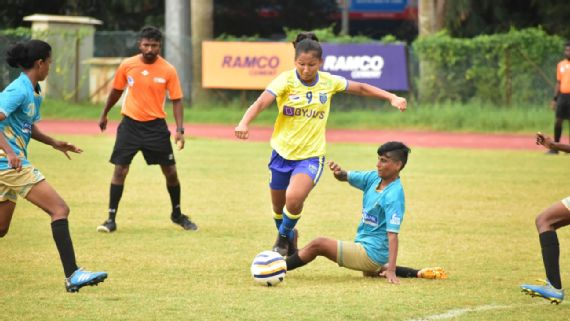ISL giants to IWL hopefuls -Kerala Blasters
ISL giants to IWL hopefuls – Kerala Blasters: Given our status as one of Asia’s most prestigious clubs, we felt it was only fitting to include this crucial component.
When asked why the women’s squad had to be established this season, Rajah Rizwan, women’s team and academy director for Kerala Blasters FC, had a straightforward answer: “This is the inevitable next step for us, one that makes the club whole.”
It took a long time to plan, with club discussions slowed by the financial difficulties the team (and every other big football club in the country) faced.
But once the decision was made, everything moved at lightning speed to put it into action. Upon receiving the go-ahead, a month later, a group of 29 was assembled. Their first official match as a squad was on day 19 of their training camp.
The Blasters’ brand value is significantly higher than most in India, but that didn’t save them from the same difficulties that every other Indian club in women’s football suffers.
The challenges within women’s football in India
Technically, it’s quite difficult to construct a women’s team, says Rizwan, who was previously instrumental in establishing Gokulam Kerala’s powerhouse women’s side.
The lack of a professional scouting system, combined with the reluctance of players to sign long-term contracts because of other obligations (education, work), and the general fuzziness of the system, renders long-term planning extremely difficult.
In other leagues, scouts had to rely on word of mouth among coaches and former players. The most crucial factor in participating in the KWL was accessibility, as other state leagues were also taking place simultaneously.
Nothing could have prepared them for what was to come.
The majority of Indian players, as both Rizwan and head coach Shareef Khan point out, are not professionals (not in terms of attitude, but in the literal definition of the term). This meant that for the majority of the 18 days of preseason, the players had to put in double training-cum-conditioning sessions to get them match and physically ready.
However, the outcomes can now be observed. Currently sitting in second place with 19 points (6W, 1D), 54 goals scored, and 7 goals allowed, their lone loss came against league leaders Lords FA (a 4-4 draw).
Malavika P, their star, is a classic Blasters’ player in every way: she’s only 19 years old, she was born and raised in Kasaragod, Kerala, and she’s a natural talent with the ball (she has ten goals and leads the club charts).
Malavika and half the team are locked into long-term contracts, but it was difficult to secure such deals. It’s a problem every club has to deal with: the IWL’s one-state, one-team qualification system. In what ways can the Blasters’ inability to win the KWL prevent them from making the cut for the major leagues?
It’s not simple to even become eligible for consideration. They may have the largest ‘name’ in the league on paper, but underneath it all they are just a young, inexperienced squad. They are situated between two really high-quality teams on the board.
The opposition
With a perfect record, the Lords of Kochi are the best team in the league. As a team, they have scored 101 times in seven games (dramatic pause).
The +94 goal differential is double the -48 of the Blasters. Both India’s playmaker extraordinaire Indumathi Kathiresan (who has 30 goals) and Myanmar’s prolific striker Win Theingi Tun (who has 42 goals) are absolute A-listers on a sub-continental level.
A few weeks ago, they set a new league record with a 33-1 victory over Kadathanad Raja FA. The team’s physio sent the following tweet after the game: “We lost track of the score and the number of goals scored several times throughout the game. It was completely absurd.”
However, this “crazy” team is not even considered to be in the title race.
That’s because Gokulam Kerala FC, the two-time defending national champions, are in third place (having played one game less).
They have played six games, won all six, scored 67 goals, and allowed zero goals. They appear like they have something to prove after failing to win the AFC Asian Women’s club title. SBFA Poovar can attest to this, as they were just beaten 21-0 by the winning team.
Long term issues
Rizwan is concerned that the IWL might not continue without the two-time champions, Gokulam Kerala, if they were to lose.
For the Blasters, and any other team considering or already investing in women’s football, this highlights the theoretical question of long-term planning.
When there is no guarantee of widespread distribution on a national scale, how can you develop a technological or commercial strategy for the next five years? If the IWL is not guaranteed, then it is impossible to guarantee AFC tournament participation.
The Blasters are doing what they can within the current framework to alleviate the problem, such as attempting to arrange friendlies and participating in tournaments elsewhere.
However, a long-term solution would be to properly revamp the structure of women’s football and introduce a more constant league, similar to the ISL and the I-league. The majority of their long-term contracts are “flex-contracts,” which allow players to be loaned out to other teams in the event that the Blasters are not selected for the national league.
Despite the difficulties, the Blasters’ entry into women’s football can be celebrated. Only massive organizations can afford to take the kind of calculated risks that will propel the world forward.
The women’s squad still has a ways to go before they connect with their fans on the same level (in terms of volume and depth) as the men’s side, but this is the kind of encouraging development that gives rise to optimism. When it comes to women’s football in India, more is better.

